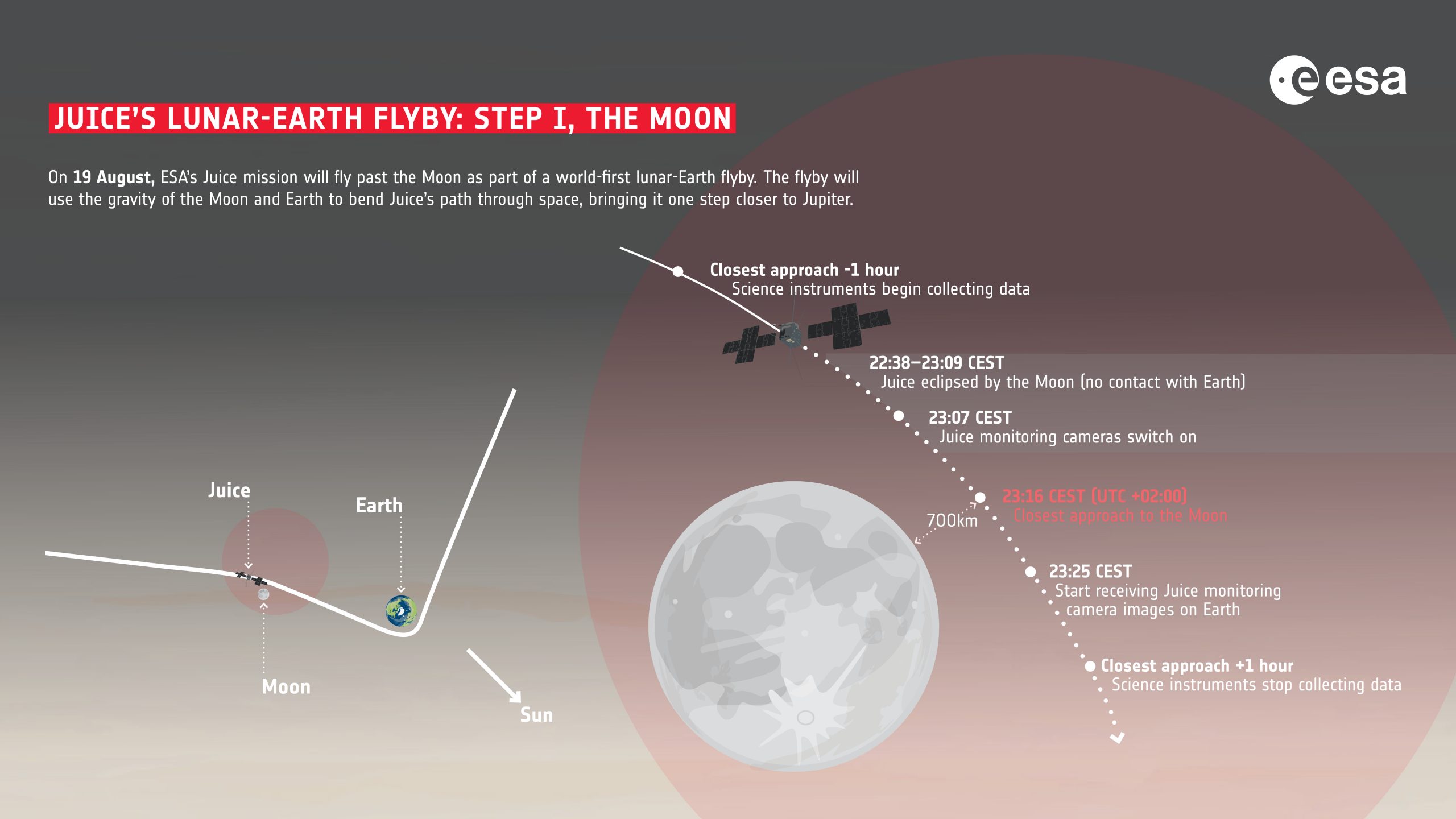At 23:15 CEST tonight, 19 August, ESA’s Jupiter Icy Moons Explorer (Juice) will pass just 750 km from the Moon’s surface as part of the first gravity assist in its eight-year journey to Jupiter.
Join us for live images of the Moon and a Q&A with the team
We will be hosting a 30-minute livestream from ESA’s European Space Operations Centre (ESOC) in Darmstadt, Germany, from 23:30 CEST tonight, 19 August, until around 00:00 CEST on 20 August, during which we will share images of the Moon captured by Juice as it flies past.
Join the livestream on YouTube or on the @ESA_Juice X channel, formerly Twitter, to be among the first to see these images. You will also be able to use the YouTube chat and X comments section (alert us with the hashtag #askESA) to ask questions about Juice to members of the spacecraft’s operations and science teams.
The timeline
Our livestream will begin at 23:30 CEST, shortly after Juice has passed its closest point to the Moon. It is at this time that we start receiving the images captured by Juice.
Just minutes after acquiring images of the Moon, Juice will begin to transmit them down to our ground station in Cebreros, Spain, one of ESA’s three deep space communication stations. From there, the data will be forwarded to ESOC in Germany, where will we share them with you as soon as we have them. The total delay between acquisition in space and appearance on the livestream will be approximately half an hour.

About the images…
The live images from Juice will be captured using the spacecraft’s two ‘monitoring cameras’, which provide 1024 x 1024 pixel, black-and-white snapshots, that can be processed in colour. We have decided to switch the cameras on, instructing them to take images at a rate of roughly two per minute as Juice makes its closest approach to the lunar surface.
These cameras were designed to monitor the unfolding of Juice shortly after launch, as it stretched out its solar panels, antennas and booms in space. They already did their job, helping to confirm successful deployments and troubleshoot issues. Now that Juice is all set for Jupiter, their task is complete!
The decision to photograph the Moon during Juice’s flyby is something of an experiment. We hope that they might be able to capture some nice images, but this is the first time that Juice has passed so close to a big, bright object like a moon or a planet, so we haven’t yet had an opportunity to test or calibrate them to take this kind of image. On top of this, we’re not 100% sure where exactly the cameras are pointing: these images will actually help us check that our understanding of the current camera alignment is correct.
We’ll share the images publicly before we’ve even had a chance to process them at all, so cannot promise any level of quality – but that’s what makes this an exciting experiment, let’s come together to see what happens!

To give an impression, this test image was taken by one of Juice’s monitoring cameras during preparations for the lunar-Earth flyby. The image looks very dark because it was taken using an exposure time that we expect will produce nice images of the Moon, which is much brighter than the parts of the spacecraft seen here.
Even if the images end up resembling those of a 1990s webcam, we will continue to run the Q&A with the Juice team, so if there is anything you want to know about Juice, its lunar-Earth flyby or about Jupiter and its mysterious icy moons, this is your chance to ask!
It’s important to note that these images have nothing to do with flying Juice and are not related to the scientific activities carried out by Juice’s other instruments. But we figured you might like to see them!
Tomorrow, once we’ve had time to process the images from the monitoring cameras, we will share updated versions. Juice’s scientific camera JANUS will also be switched on during the flyby of the Moon, getting its first opportunity to take high-resolution images on a planetary surface in space; we will share these images in the coming days and weeks.
Can’t join us? Give the full Moon a wave tonight!
Can’t join us live but still want to feel part of Juice’s Moon flyby? Well, tonight happens to be a full Moon! The Moon will be big and bright tonight, so, if you’re able to see it at around 23:00 CEST, give it a wave! It’s right there that Europe’s first mission to the largest planet in the Solar System, Jupiter, will be taking photos, doing important science, and most crucially, being rerouted towards Earth. After passing the Moon, Juice will head towards its home planet for the second half of its historic lunar-Earth flyby on Tuesday night.
A big thank you to the Juice teams who helped make this science communication experiment possible!

Discussion: 14 comments
This story about the Juice monitoring cameras (JMC) seems to be somewhat in contradiction to information given on the contractors site. By the way, why was the especially developed calibration chart (CC) not mounted on the spacecraft?
Will it be possible for us to see the Jupiter Icy Moons Explorer in the night sky?
It depends where you are in the world. Unfortunately the chances are effectively zero for seeing Juice from Europe, it passes closest over Southeast Asia and the Pacific Ocean.
It is important to mention that Juice is a difficult object to observe. It’s much further away than the low-Earth orbit satellites that we sometimes see in the sky at dusk and dawn. A good knowledge of observational astronomy and the right equipment would be crucial.
According to the Cruise report, early on 17 August, the JUICE solar array was for a about one and a half minutes turned parallel to the sun direction. What could be an explanation this maneuver?
During the current phase of the mission, whilst Juice is relatively close to the Sun, it is keeping its solar arrays tilted to avoid overheating them. Perhaps it was a cooling manoeuvre?
Why no mention of time of earth flyby? What time is earth flyby? How close to earth? How fast is moon and earth flybys? Expect any earth imaging?
The Earth flyby is tonight, with closest approach at 23:56 CEST. Juice’s monitoring cameras will again be switched on and we will share some of them tomorrow.
More information here: https://www.esa.int/ESA_Multimedia/Images/2024/07/Juice_s_lunar-Earth_flyby_step_II_Earth
Wünsche der Mission viel Erfolg!
I assume there is a strict program to visit the moons of Jupiter – are you planning to release a schedule?
It is very exciting to see images from a European satellite. Thanks for sharing.
Indeed, JUICE has to be in the correct place at the correct time. At best the distance from the target body could be too great and firstly the science will not be as good and secondly for avigation purposes JUICE will need to use more fuel to correct. Too close, there is a risk of impact.
Why such a slow rate of return of data?
JUICE is very close to earth right now, data should be very fast at such a short range?
There are two reasons. Firstly, during the current phase of the mission, whilst Juice is relatively close to the Sun, it is keeping its high-gain antenna pointed towards the Sun to act as a heat shield. Secondly, the International Telecommunication Union requires that Juice uses its low-gain antenna to communicate with Earth during the flyby.
ABOUT THE IMAGES…
Great!
I was wondering if one day it would be possible to have the raw formats of these images, freely downloadable. I would be interested in personal study in the processing of unprocessed images.
Take a look at our Planetary Science Archive, where you can find raw data and partially processed images: https://psa.esa.int/psa/#/pages/search